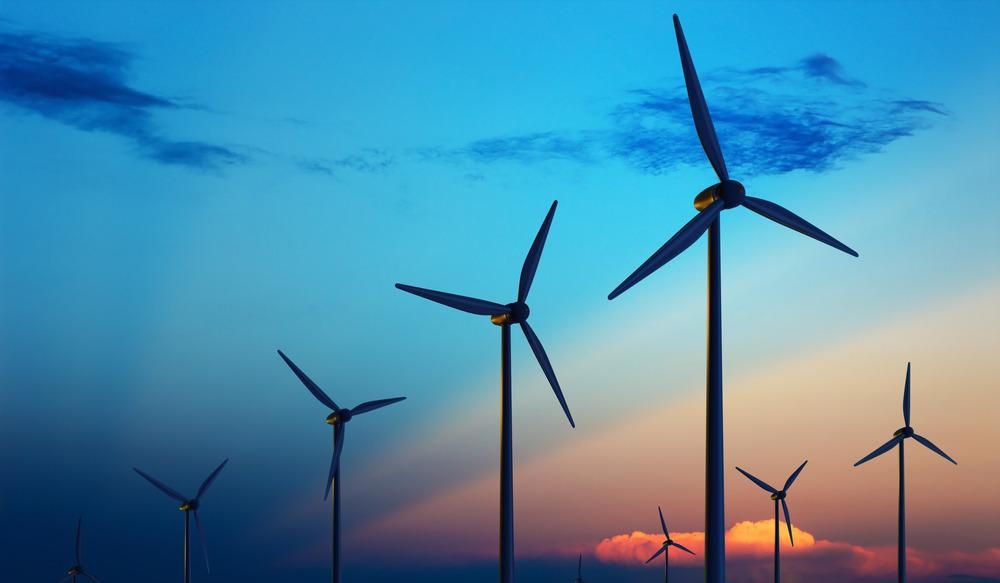The economics of wind energy depends on wind turbines operating at maximum efficiency for as long as possible. To maximize energy output and minimize maintenance costs, wind farm operators install numerous sensors on their wind turbines. These tiny, relatively inexpensive devices enable skyscraper-sized wind turbines to operate as efficiently and safely as possible.

Image Credit: Johan Swanepoel/Shutterstock.com
The Engineering Challenge of Harnessing Wind Energy
Wind turbines are very large, complex, and technical engineering structures. They are designed with optimum efficiency in mind, as the rate at which they can capture wind energy directly impacts on the profitability and effectiveness of wind farms.
Efficiency is reduced when any of the more than 8,000 components inside a wind turbine degrades to below an acceptable level. Component degradation is common in these structures due to the extremely demanding conditions that they operate in.
Components must withstand a significant amount of motion and friction from other parts as the mechanical structure of a wind turbine is constantly moving. Due to being placed in extreme weather conditions where more wind occurs – offshore or onshore in mountainous areas, for example – manual wind farm maintenance is very expensive and dangerous.
When this mechanical wear is combined with weather damage, the result is a breakdown of materials and components, leading to reduced efficiency in the system or even eventually whole system failures.
Sensors in Wind Turbines
To maximize efficiency and minimize maintenance costs, many different types of electrical and optical sensors are used to monitor and record the performance of individual components in the wind turbine.
These sensors, in general, meet three main demands for wind turbine maintenance:
- They detect, monitor, and communicate data regarding the moving dimensions of the wind turbine – determining the distance between components and changes over time.
- They monitor vibration levels in the entire turbine system. If the turbine as a whole is vibrating too much, then efficiency reduces, and significant damage can occur.
- Or they monitor changes in temperature and pressure in the system or changes in mechanical stresses exerted on components.
Industrial Internet-of-Things
Condition-monitoring systems (CMSs) comprise all the sensors, connections, and central computing that contribute to the effective detection, monitoring, and communication of key information for wind turbines’ performance.
Wind turbine CMSs are an example of the industrial internet-of-things (IIoT). This is the name for the universal network of smart industrial devices connected by internet technology, or for smaller, local networks within it.
Typically, nodes within the CMS network will be connected via Ethernet cables instead of wireless. However, wireless connection to central servers bridges the information so that human monitoring can take place remotely.
IIoT networks in wind energy can use historical operating data on the wind speed, power, yaw angles, gearbox temperature, vibration, material degradation, and other factors to optimize the maintenance and operation of each wind turbine.
Eddy current sensors are some of the most common sensor types for wind turbines. Eddy current, or Foucault current, sensors are used to measure the lubrication gap in turbine shafts to ensure proper lubrication of the part.
Displacement sensors are used in wind turbines to check the structural integrity of their components. Especially important is monitoring the concrete base of the turbine, as the structure is extremely large and top-heavy.
Laser displacement sensors are used to detect movements in the structure’s foundation in relation to the turbine itself, providing early warning signs of potentially major problems later.
References and Further Reading
Powers, Mike (2013). The Importance of Sensors in Wind Turbine O&M. RenewableEnergyFocus.com. [Online] http://www.renewableenergyfocus.com/view/35263/the-importance-of-sensors-in-wind-turbine-o-m/.
Rabenau, Bryan (2019). How Disruptive Technology Is Changing Condition-monitoring Systems in Wind Turbines. Windpower Engineering & Development. [Online] https://www.windpowerengineering.com/how-disruptive-technology-is-changing-condition-monitoring-systems-in-wind-turbines/.
Vella, Heidi (2021). When Lightning Strikes: Managing Impacts On Wind Turbines. Power Technology. [Online] https://www.power-technology.com/features/when-lightning-strikes-managing-impacts-on-wind-turbines/
Disclaimer: The views expressed here are those of the author expressed in their private capacity and do not necessarily represent the views of AZoM.com Limited T/A AZoNetwork the owner and operator of this website. This disclaimer forms part of the Terms and conditions of use of this website.